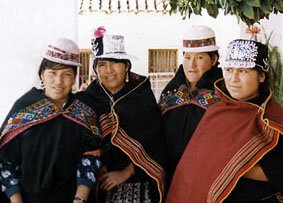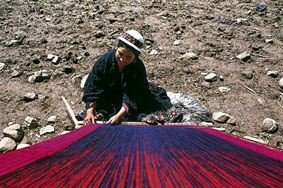 |
DESCRIPTION OF ASUR'S ACTIVITIES,
PROGRAMS AND PROJECTS:
Casa Capellanica. Calle San Alberto No 413
Telefono (591) (64) 53841
Fax (591) (64) 62194
asur@mara.scr.entelnet.bo Casilla
662 - Sucre - Bolivia |

THE JALQ'A-TARABUCO PROGRAM
 |
In 1987, after a year of research and planning in the Jalq'a
region, ASUR initiated the Jalq'a Textile Project in the community of Irupampa.
Its objectives included:
The revival of rapidly-disappearing traditional weaving techniques.
The sale of the resulting textiles to provide an alternative
income source for peasant families.
The alleviation of poverty in a region with deteriorating
agricultural opportunities. |
 The last years have shown considerable success: The last years have shown considerable success:
The project has grown to include several other communities.
A new project was launched: the Tarabuco Textile Project.
The two projects now encompass 16 female workshops in as many communities,
distributed among the two regions (Jalq'a and Tarabuco). And 5 male production
units.
Around 1,000 weavers are enrolled in the projects.
The population benefitting from the project is estimated at some 5830
people. (weavers and their families).
The Jalq'a-Tarabuco Textile Project has successfully:
Increased the production of textiles. Significantly improved the quality
of the textiles produced. Established a textile shop in the Casa Capellánica
in Sucre. Increased the sale of textiles. Given numerous indigenous families
another option for improving the condition of their lives.
 The main success of the Jalq'a -Tarabuco Textile Project
lies in the combination of economic income with the development of aesthetic
creativity. In spite of the recent increase in production, the pieces of
clothing have not been degraded nor "folklorized". The intensity
of textile labour, together with increased communication between communities
and weavers, has instead accelerated the processes of change in the designs.
Change, always present in any living tradition, is now released in a far
more impassioned search for the best way of expressing messages characteristic
of each region.The weavers have not tried to adapt to the tastes of the
market; rather, they are aware that what they offer are, precisely, visions
of the world which differ from those of the observer, glimpses of another
soul, someone else's thoughts, which are given material form in the interweaving
of coloured threads. The main success of the Jalq'a -Tarabuco Textile Project
lies in the combination of economic income with the development of aesthetic
creativity. In spite of the recent increase in production, the pieces of
clothing have not been degraded nor "folklorized". The intensity
of textile labour, together with increased communication between communities
and weavers, has instead accelerated the processes of change in the designs.
Change, always present in any living tradition, is now released in a far
more impassioned search for the best way of expressing messages characteristic
of each region.The weavers have not tried to adapt to the tastes of the
market; rather, they are aware that what they offer are, precisely, visions
of the world which differ from those of the observer, glimpses of another
soul, someone else's thoughts, which are given material form in the interweaving
of coloured threads.
DIVERSIFICATION IN TEXTILE PRODUCTION:
OTHER PRODUCTION UNITS
Over the last three years, ASUR has also organized a group of small production
units in some of the same communities where the women's textile workshops
operate. These units receive advice from ASUR and maintain close relations
with the other groups through textile-related activities. By offering new
and different products which demonstrate local indigenous creativity, these
groups are an important force for diversifying the Textile Project's production.
* The Communal Enterprise at Irupampa
This is the largest of the units, employing 58 persons (almost all of the
community's families are involved). The enterprises include:
- a successful dyeing workshop which experiments with and produces natural
dyes.
- a number of haberdasheries.
- a small hydroelectric plant, which will provide energy for the spinning
mill and employment for a few members of the community.
* The Mattress Workshop at Marawa
In order to utilize residual wool, the community of Marawa has established
a mattress-making workshop which:
employs 15 men and one woman, produces high-quality mattresses which are
made to order and sold in the city of Sucre.
* The Bayeta Workshop at Marawa
Also in Marawa, a group of weavers has organized to make bayetas (woolen
cloths woven using pedal looms); the objective is to produce especially
fine cloth.The project began with the training of 10 weavers.Currently,
16 weavers produce fine shawls which are sold in ASUR's textile store.Several
other community members await their turn for training and integration into
the project.
* Embroidery in Majada
Thirteen members of the community of Majada have been trained in pre-Hispanic
embroidery techniques. They work closely with the bayeta-makers of Marawa
to produce fine pre-Colombian style embroidered cloth for use in making
clothing.
* Tapestry-making in Potolo
The training given in the community of Potolo has led to the establishment
of a mens' tapestry production unit.
Weaving techniques recovered from the pre-Columbian era are being used.These
tapestry-makers are the only ones in the Andean region who are reviving
and continuing the practice of these ancient techniques.The group is composed
of 16 weavers whose success in this enterprise is inspiring others to undergo
training.These weavers are passing these techniques to weavers in other
communities within Tarabuco. |
 |
* Tapestry-making in Pila Torre
The tapestry-makers of Potolo (Jalq'a region) have already passed along
pre-Hispanic weaving techniques to 12 male apprentices from the community
of Pila Torre (Tarabuco region). Currently, 20 weavers produce fine tapestries.
* The Ceramic Program
The Ceramic Program operates with indigenous peasants of the Ch'uta ethnic
group. This project has three main components:
| 1 |
Supporting families who practice the pottery traditions of
generations ago and produce all variety of traditional pieces. |
| 2 |
Working with the producers of construction ceramics. |
| 3 |
Organizing a Central Workshop, where potters produce high-quality
ceramics for daily use (table service, flowerpots, etc.). |
Underlying these three focus points are several general objectives:
- to revive traditional pottery techniques
- to improve kilns and firing methods
- to improve the quality and variety of ceramic production
- abrir nuevos mercados
- to train indigenous potters
- to open new markets for ceramics
- to improve the prices received by producers.

[ASUR] [Geografic
Area] [Museum] [Textiles] |
| 

 The last years have shown considerable success:
The last years have shown considerable success: The main success of the Jalq'a -Tarabuco Textile Project
lies in the combination of economic income with the development of aesthetic
creativity. In spite of the recent increase in production, the pieces of
clothing have not been degraded nor "folklorized". The intensity
of textile labour, together with increased communication between communities
and weavers, has instead accelerated the processes of change in the designs.
Change, always present in any living tradition, is now released in a far
more impassioned search for the best way of expressing messages characteristic
of each region.The weavers have not tried to adapt to the tastes of the
market; rather, they are aware that what they offer are, precisely, visions
of the world which differ from those of the observer, glimpses of another
soul, someone else's thoughts, which are given material form in the interweaving
of coloured threads.
The main success of the Jalq'a -Tarabuco Textile Project
lies in the combination of economic income with the development of aesthetic
creativity. In spite of the recent increase in production, the pieces of
clothing have not been degraded nor "folklorized". The intensity
of textile labour, together with increased communication between communities
and weavers, has instead accelerated the processes of change in the designs.
Change, always present in any living tradition, is now released in a far
more impassioned search for the best way of expressing messages characteristic
of each region.The weavers have not tried to adapt to the tastes of the
market; rather, they are aware that what they offer are, precisely, visions
of the world which differ from those of the observer, glimpses of another
soul, someone else's thoughts, which are given material form in the interweaving
of coloured threads.